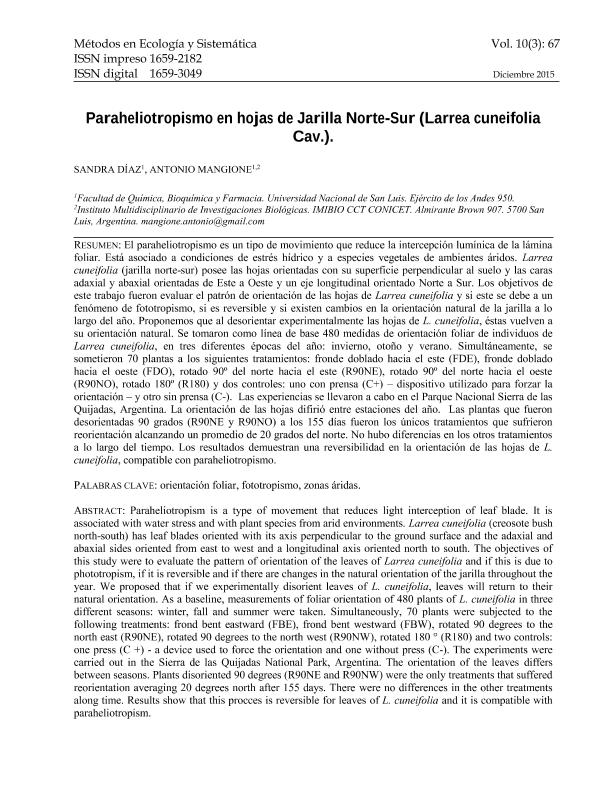Artículo
El paraheliotropismo es un tipo de movimiento que reduce la intercepción lumínica de la lámina foliar. Está asociado a condiciones de estrés hídrico y a especies vegetales de ambientes áridos. Larrea cuneifolia (jarilla norte-sur) posee las hojas orientadas con su superficie perpendicular al suelo y las caras adaxial y abaxial orientadas de Este a Oeste y un eje longitudinal orientado Norte a Sur. Los objetivos de este trabajo fueron evaluar el patrón de orientación de las hojas de Larrea cuneifolia y si este se debe a un fenómeno de fototropismo, si es reversible y si existen cambios en la orientación natural de la jarilla a lo largo del año. Proponemos que al desorientar experimentalmente las hojas de L. cuneifolia, éstas vuelven a su orientación natural. Se tomaron como línea de base 480 medidas de orientación foliar de individuos de Larrea cuneifolia, en tres diferentes épocas del año: invierno, otoño y verano. Simultáneamente, se sometieron 70 plantas a los siguientes tratamientos: fronde doblado hacia el este (FDE), fronde doblado hacia el oeste (FDO), rotado 90º del norte hacia el este (R90NE), rotado 90º del norte hacia el oeste (R90NO), rotado 180º (R180) y dos controles: uno con prensa (C+) ? dispositivo utilizado para forzar la orientación ? y otro sin prensa (C-). Las experiencias se llevaron a cabo en el Parque Nacional Sierra de las Quijadas, Argentina. La orientación de las hojas difirió entre estaciones del año. Las plantas que fueron desorientadas 90 grados (R90NE y R90NO) a los 155 días fueron los únicos tratamientos que sufrieron reorientación alcanzando un promedio de 20 grados del norte. No hubo diferencias en los otros tratamientos a lo largo del tiempo. Los resultados demuestran una reversibilidad en la orientación de las hojas de L. cuneifolia, compatible con paraheliotropismo. Paraheliotropism is a type of movement that reduces light interception of leaf blade. It is associated with water stress and with plant species from arid environments. Larrea cuneifolia (creosote bush north-south) has leaf blades oriented with its axis perpendicular to the ground surface and the adaxial and abaxial sides oriented from east to west and a longitudinal axis oriented north to south. The objectives of this study were to evaluate the pattern of orientation of the leaves of Larrea cuneifolia and if this is due to phototropism, if it is reversible and if there are changes in the natural orientation of the jarilla throughout the year. We proposed that if we experimentally disorient leaves of L. cuneifolia, leaves will return to their natural orientation. As a baseline, measurements of foliar orientation of 480 plants of L. cuneifolia in three different seasons: winter, fall and summer were taken. Simultaneously, 70 plants were subjected to the following treatments: frond bent eastward (FBE), frond bent westward (FBW), rotated 90 degrees to the north east (R90NE), rotated 90 degrees to the north west (R90NW), rotated 180 ° (R180) and two controls: one press (C +) - a device used to force the orientation and one without press (C-). The experiments were carried out in the Sierra de las Quijadas National Park, Argentina. The orientation of the leaves differs between seasons. Plants disoriented 90 degrees (R90NE and R90NW) were the only treatments that suffered reorientation averaging 20 degrees north after 155 days. There were no differences in the other treatments along time. Results show that this procces is reversible for leaves of L. cuneifolia and it is compatible with paraheliotropism.
Paraheliotropismo en hojas de Jarilla Norte-Sur (Larrea cuneifolia Cav.).
Fecha de publicación:
12/2015
Editorial:
Instituto Centroamericano para la Investigación en Biología y Conservación
Revista:
Métodos en Ecología y Sistemática
ISSN:
1659-2182
e-ISSN:
1659-3049
Idioma:
Español
Tipo de recurso:
Artículo publicado
Clasificación temática:
Resumen
Palabras clave:
ORIENTACION FOLIAR
,
FOTOTROPIA
,
ZONAS ÁRIDAS
Archivos asociados
Licencia
Identificadores
Colecciones
Articulos(IMIBIO-SL)
Articulos de INST. MULTIDICIPLINARIO DE INV. BIO. DE SAN LUIS
Articulos de INST. MULTIDICIPLINARIO DE INV. BIO. DE SAN LUIS
Citación
Diaz, Sandra Mabel; Mangione, Antonio Marcelo; Paraheliotropismo en hojas de Jarilla Norte-Sur (Larrea cuneifolia Cav.).; Instituto Centroamericano para la Investigación en Biología y Conservación; Métodos en Ecología y Sistemática; 10; 3; 12-2015; 67-74
Compartir




